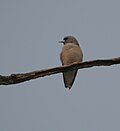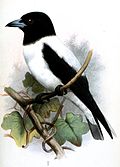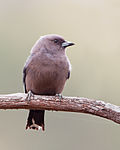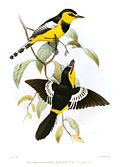| Woodswallows | |
|---|---|
 | |
| Dusky woodswallow (Artamus cyanopterus) | |
| Scientific classification | |
| Kingdom: | Animalia |
| Phylum: | Chordata |
| Class: | Aves |
| Order: | Passeriformes |
| Family: | Artamidae |
| Subfamily: | Artaminae C. G. Sibley & J. A. Ahlquist, 1990 |
| Genus: | Artamus Vieillot, 1816 |
| Type species | |
| "Langraien" Buffon = Lanius leucorhynchus Linnaeus, 1771 | |
| Species | |
11, see text | |
Woodswallows are soft-plumaged, sombre-coloured passerine birds in the genus Artamus. The woodswallows are either treated as a subfamily, Artaminae, in an expanded family Artamidae (also including the subfamily Cracticinae), or as the only genus in that family (with the butcherbirds, currawongs, and allies placed in a separate family, Cracticidae). The generic name, which in turn gives rise to the family name, is derived from the Ancient Greek artamos, meaning butcher or murder. The name was given due to their perceived similarity to shrikes. A former common name for the group was "swallow-starlings". [1]


















